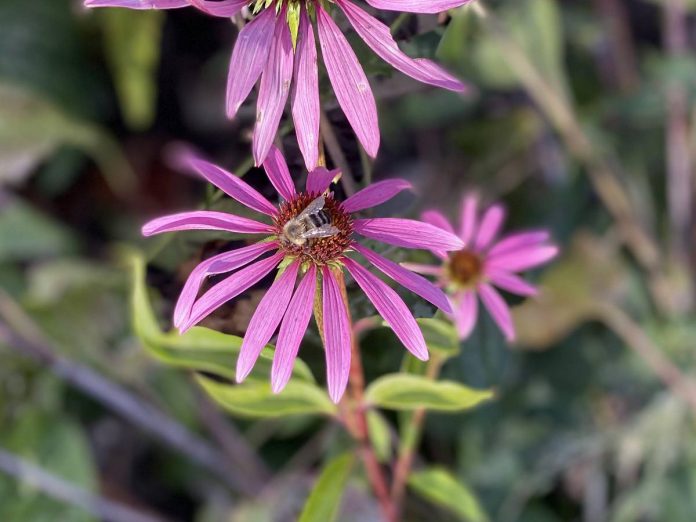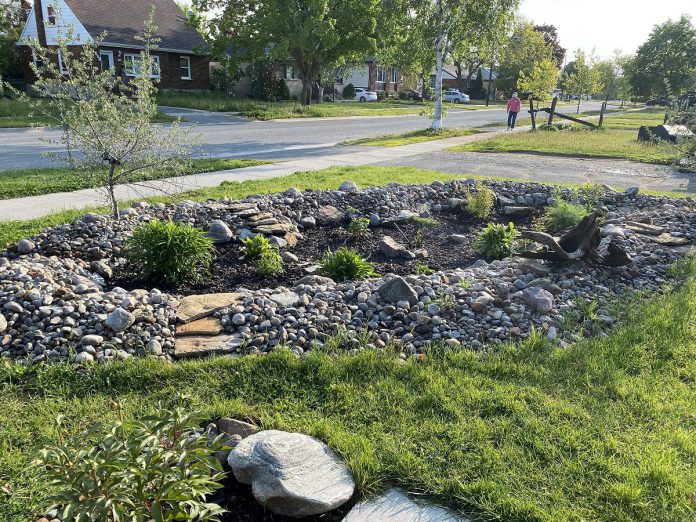
Rain gardens are beautiful and highly practical green infrastructure. In the summer of 2022, GreenUP Program Coordinator Hayley Goodchild wrote five facts about rain gardens and this week it’s time to revisit them.
Just two weeks ago, while Toronto was experiencing a major rain fall event that caused extensive flooding of homes and infrastructure, we were marking the 20th anniversary of the historic flood that took place in Peterborough in July 2004.
In recognition of the anniversary, the City of Peterborough released an interactive story map that reflects on the flood, and shows all the work that has taken place since then to better equip our city for rainfall of that magnitude.
Along with major investments in our infrastructure, the City of Peterborough encourages residents to play a role in reducing the amount of runoff that reaches the storm sewer system by managing storm water at home through the city’s Rain Garden Subsidy Program.
For those new to the concept, rain gardens are bowl-shaped gardens that absorb stormwater runoff from nearby hard surfaces, such as a roof or an asphalt driveway. The plants and soil clean the rainwater by filtering out pollutants and slowly allow the water to filter into the soil.
Rain gardens come in many shapes, sizes, and styles, depending on the specifics of your space and your personal gardening style. In all their forms, a well-built rain garden is a great way to use your yard as part of a community wide approach to manage storm water better.
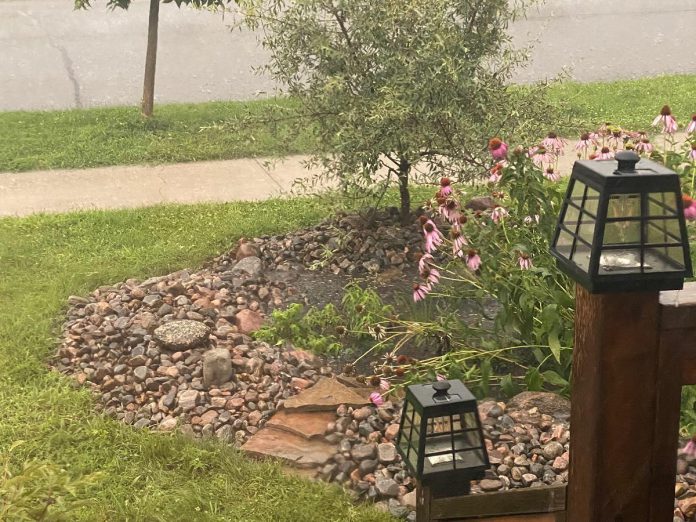
Here’s five facts that Hayley Goodchild shared about rain gardens in 2022. We think they still make a compelling case to build one!
1. A rain garden can divert almost 10 bathtubs’ worth of water from storm sewers each year
An average residential rain garden in Peterborough can divert about 1.5 cubic metres of water from the storm sewer system each year. That’s roughly the same volume as 9.5 bathtubs.
Without treatment, runoff carries garbage and pollutants straight into the watershed. Here in Peterborough, 75 per cent of runoff goes untreated. By sending rainwater to a rain garden instead, you can harness the power of soil and plants to filter pollutants as water soaks into the ground.
Imagine the potential for the watershed if more homeowners, schools, and businesses installed rain gardens on their properties. That’s a lot of bathtubs.
2. Rain gardens are often dry
Unlike a pond, rain gardens are designed to temporarily store water until it can be absorbed into the ground. Ideally, water in a rain garden will drain within 24 to 48 hours of a heavy rain event.
During the summer, established rain gardens can go many weeks without water.
The best part? Fewer mosquitoes in your garden!
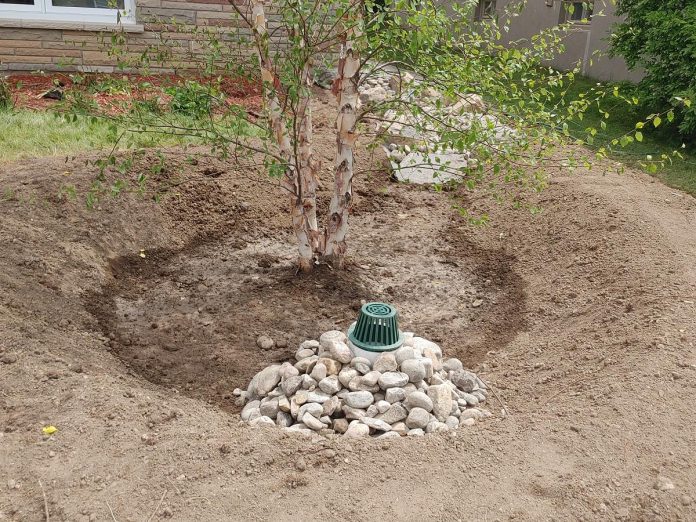
3. Rain gardens provide wonderful entertainment
As soon as you install one, you’ll fly out the door at the first hint of rain to watch the bowl fill and recede. Trust me, you will!
And that’s not even to mention the increase in butterfly traffic to your new native pollinator plant species.
4. You can incorporate trees into your rain garden if your space allows
It’s important to build your rain garden outside the canopy of any existing trees to protect their roots. However, there’s no reason why you can’t plant a new tree in your rain garden. Planting trees is critical for adapting to climate change, especially since extreme weather events can damage the urban tree canopy.
Some of our favourites include River Birch (Betula nigra), Hackberry (Celtis occidentalis), Eastern White Cedar (Thuja occidentalis), and Serviceberry (Amelanchier spp.). These native trees and large shrubs are well-suited to the variable moisture conditions found in rain gardens.
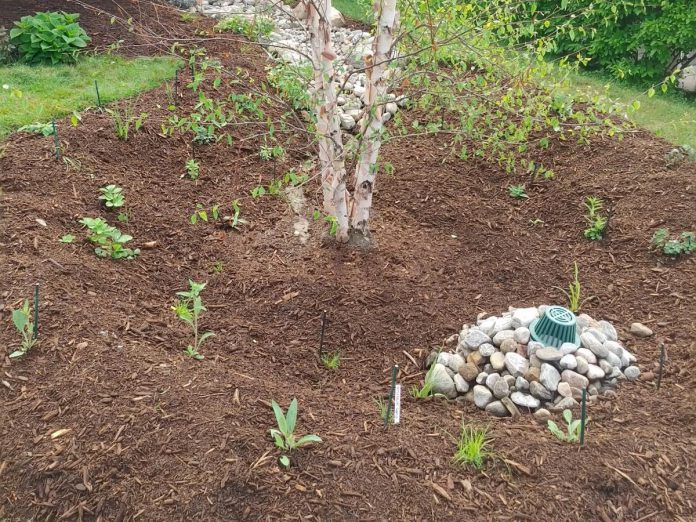
5. Eligible homeowners can receive up to $1,000 from the City of Peterborough to install a rain garden at home
The increasing impacts of climate change on our region will include more precipitation in shorter amounts of time. The City of Peterborough is investing in rain gardens because cumulatively, they can reduce the amount of runoff the municipal stormwater system has to manage during heavy storms.
In addition to the subsidy, GreenUP is partnering with the City of Peterborough to provide applicants with consultation visits and customized advice to help as you adapt your yard to respond to the impacts of climate change.
The subsidy covers the costs of plants, soil, mulch, rock, and other non-equipment expenses incurred while building a rain garden. The subsidy can also be used to hire a landscape contractor for design and/or construction of your rain garden.
If you are concerned about flooding and want to take a tangible step to increase the climate resilience of your property, we hope that you will consider learning more about the Rain Garden Subsidy Program by visiting www.peterborough.ca/raingarden. You can also direct questions Laura Keresztesi at laura.keresztesi@greenup.on.ca or by phone at 705-748-3238 ext. 206.
GreenUP can also help you source plants suitable for your rain garden. Visit the Ecology Park and speak to our staff in the Native Plant & Tree Nursery during our hours of operation (Thursdays from 10 a.m. to 6 p.m. and Fridays, Saturdays, and Sundays from 10 a.m. to 4 p.m.).
To learn more about our watershed and how stormwater is managed in Peterborough, we suggest exploring the City of Peterborough’s interactive story map called Watershed: A Turning Point. This site reflects on the storm of 2004, what has been done since to address stormwater management, and plans for future improvements through various strategies.
